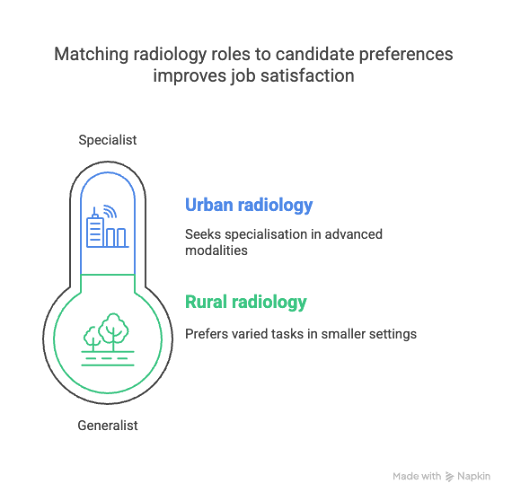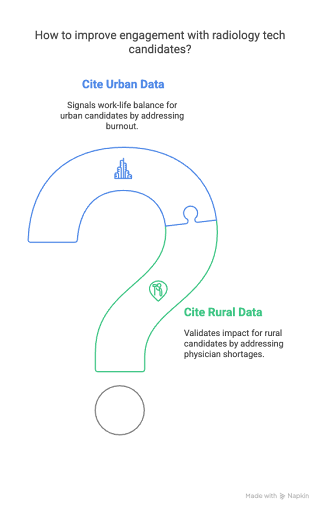Rural vs. Urban: Customizing Your Radiology Tech Recruiting Strategy by Region
“Rural hospitals just need to pay more to attract talent.” That’s the myth.
In reality, recruiting for radiology techs is about more than money, it’s about understanding the geographic location, access to health care, and systemic barriers that impact rural facilities differently from urban hospitals.
This blog post breaks down how your recruiting strategy should shift based on region.
You’ll learn what rural providers need, how urban clinician density changes the game, and why professional development opportunities aren’t a one-size-fits-all.
Why should your radiology recruiting strategy vary based on region?
Rural hospitals face a professional shortage. Unlike urban medical centers, rural facilities struggle to find and retain qualified doctors and technologists due to lower population density and fewer nearby training programs.
Patient access to diagnostic services isn’t equal. Rural patients often travel longer distances for radiology, which reduces timely access to quality imaging and affects patient outcomes.
Workforce supply differs by geographic location. Urban clinician density is higher, while rural sites suffer from clinician shortages, limiting available talent for health care services.
Retention factors vary. In rural settings, job satisfaction may hinge more on community integration, housing, and family life, while urban hospitals compete with professional development opportunities.
Electronic health records (EHR) infrastructure may be uneven. Urban practices often adopt newer systems faster, which affects how radiology techs interact with patient care technology.
Cultural expectations shift between rural and urban locations. Rural physicians may take on broader responsibilities, while urban providers often This affects hiring expectations and job scope.
Key challenges for rural and urban hospitals when recruiting radiology techs
Rural and urban hospitals face unique and different challenges when it comes to finding and recruiting the right radiology techs. Let’s take a closer look at the differences here.
For rural hospitals:
Professional shortage is critical. Many rural facilities operate in health professional shortage areas, making it harder to find qualified radiology workforce candidates.
Limited access to additional resources. Smaller budgets mean fewer incentives, limited relocation support, and restricted benefits compared to urban hospitals.
Retention of women physicians and techs is harder. A lack of spousal job options, child care, and professional development can lower job satisfaction in a rural setting.
Outdated electronic health records (EHR) systems. Rural practices may not have the latest EHR tools, which affects workflow and efficiency.
Fewer temporary placements. Traveling radiology techs are less likely to choose rural locations, especially without perks or support.
For urban hospitals:
High competition due to urban clinician density. Major cities have more medical centers, but they’re all fighting over the same pool of qualified doctors and techs.
Burnout from high patient volumes. Urban providers may deal with higher throughput, which can affect job satisfaction and staff turnover.
Complex medical practices. Urban hospitals often have more specialized roles, which require more targeted recruitment strategies for niche diagnostic services.
Less personal connection to patient care. In a large system, techs may feel disconnected from the impact of their work, which can affect long-term retention.
10 Creative Ways to Customize Your Radiology Tech Recruiting Strategy by Region
1. Use PACS and EHR Familiarity as a Filter
When recruiting radiology techs, one of the most overlooked but impactful qualifiers is familiarity with the electronic systems used in a given geographic location.
Rural hospitals often operate with outdated or limited-functionality electronic health records (EHR) and Picture Archiving and Communication Systems (PACS), which can slow diagnostic workflows and affect patient care. Urban hospitals, by contrast, tend to adopt newer, more integrated systems that demand a steeper learning curve.
According to a study by BMC, only 64% of small rural hospitals reported having advanced EHR capabilities, compared to 74% of large urban hospitals.
This difference should guide how you tailor your job listings and candidate screens. If you’re hiring for a rural setting, you may need to prioritize candidates open to additional training or those with a track record of adapting to low-resource environments.
Highlight opportunities for on-the-job learning or upskilling in PACS systems as part of the value proposition. For urban hospitals, the strategy flips. Here, filtering for system-specific experience (e.g., Epic Radiant or GE Centricity PACS) becomes a selling point and a hard requirement. The graphic below highlights this contrast.
Using PACS/EHR familiarity as a filter doesn't just improve placement speed, it improves retention. Radiology techs who enter environments that align with their technical competencies tend to onboard faster, make fewer errors, and report higher job satisfaction.
2. Map Candidates by Diagnostic Service Preferences
Radiology techs aren’t one-size-fits-all, they vary widely in their skills, certifications, and preferences for work environments. Rural hospitals typically need generalists who can handle X-rays, ultrasound, and sometimes basic CT scans with minimal support. In Canada, for instance, less than 20% of rural hospitals have access to in-house CT.
In contrast, urban hospitals and medical centers often run large imaging departments with specialized roles for MRI, interventional radiology, or nuclear medicine. That makes diagnostic service preference a key variable in how you segment your candidate pool. Instead of mass-emailing every certified tech, filter based on prior job titles, credentials, or certifications listed in resumes, this aligns your pitch with what they actually want to do. The image below illustrates this.
It’s about matching role complexity with candidate motivation. Techs who want to specialize often seek urban hospitals with access to advanced imaging modalities, larger patient volumes, and more opportunities for professional development. Those looking for varied day-to-day tasks may find more fulfillment in rural practice. Tailoring your messaging and screening accordingly helps improve job satisfaction, minimizes churn, and improves health outcomes for both urban and rural patients.
3. Leverage JAMA Network and Rural Remote Health Citations in Outreach
In recruitment, credibility is currency. When reaching out to radiology techs, especially those weighing offers across very different geographic locations, you can boost engagement by grounding your message in evidence.
Referencing reputable sources like the JAMA Network or Rural and Remote Health shows that you understand the systemic pressures techs face. For rural candidates, citing real data on physician shortages or workforce gaps validates their potential impact. For urban candidates, citing statistics on burnout or clinician density signals that your role is structured with work-life balance in mind. The image below highlights this difference.
For example, a JAMA Network report in 2024 found that when radiologists were involved in radiation oncology peer review with the radiotherapy plan, higher rates of plan changes were observed.
Including stats like these in email subject lines, LinkedIn messages, or ad copy makes your pitch both smarter and more relevant.
This tactic is about mirroring the candidate’s context. If you're recruiting for a rural location, highlight how joining the radiology workforce there directly addresses access to health care and improves patient outcomes. If you're filling a high-volume role in an urban medical center, emphasize structured hours, adequate support staff, or wellness incentives as burnout countermeasures.
4. Recruit with “Community Impact” Narratives for Rural Locations
When recruiting radiology techs for rural hospitals, one of the strongest selling points isn’t the salary, it’s the impact. Many candidates, especially early-career professionals or those burnt out from volume-heavy urban jobs, are actively looking for roles where they feel they matter.
Highlighting how rural providers directly influence health outcomes in underserved communities can turn a passive candidate into an engaged one. Research has found that rural populations have a 23% higher mortality rate than urban ones, largely due to a lack of access to diagnostic services and early detection tools like imaging. The image below breaks down the impact a good rural radiologist can have:
Framing your outreach around community impact adds emotional value to the offer. Radiology techs working in rural facilities often serve as the only imaging professionals for miles, meaning their scans are the first and sometimes only line of defense in a patient's care journey. That kind of narrative resonates with mission-driven hires who want more than just a job, they want purpose.
This is about emotional segmentation. Not every tech wants prestige or fast-paced environments. Some are driven by service, equity, and connection. If you're filling roles in rural sites, build your outreach around real stories, not just job descriptions. Talk about how that tech will help rural patients access care they otherwise wouldn’t get, or how their presence enables the hospital to offer mammography, dental care imaging, or stroke triage locally.
5. Offer Rotation-Based Contracts Across Geographic Locations
Rotation-based contracts, where radiology techs split their time between urban hospitals and rural sites, solve multiple problems at once. For rural facilities, it helps address the chronic professional shortage and improves access to diagnostic services without the full burden of permanent hiring. For urban hospitals, it creates a new value proposition for techs who want more variety and the chance to expand their skill set.
Check out the following image for some of the benefits of rotation-based contracts:
The number of radiologists is dropping. The number of people per active radiologist in the U.S. grew by 10% between 2007 and 2021, and rural areas are especially hard-hit.
Urban clinicians who rotate into rural settings may benefit from reduced burnout and increased patient connection. These hybrid roles also offer exposure to a wider range of medical practices, including different imaging modalities, patient demographics, and care delivery models.
For recruiters, pitching a rotation model shows you’re serious about solving the systemic issues in radiology workforce distribution. You can position it as a strategic step in a tech’s career, one that balances the fast pace of major cities with the mission-driven work of rural health care. It also opens up new selling points: housing stipends, travel reimbursements, and accelerated credentialing across sites.
6. Run Regional Webinars Featuring Assistant Professors or Local Clinicians
Hosting webinars with trusted voices from the field, like assistant professors, imaging directors, or experienced radiology techs, adds serious weight to your recruiting strategy. These sessions aren’t just about job openings; they’re about unpacking what it’s really like to work in specific geographic locations.
Whether it’s an assistant professor from a rural teaching hospital explaining how EHR limitations affect patient care or a CT tech from a major city discussing workload and burnout, these real-world insights build trust with candidates. They also pre-qualify your audience: those who attend are more likely to be serious about the role and region.
The graphic here shows some of the advantages of these events:
As well as virtual events, there are lots of events and conferences that radiology techs can attend to continue their learning and stay up to date with current trends. Some examples are the SNMMI Mid-Winter Meeting in California and the Society of Radiopharmaceutical Sciences (SRPE) Annual Conference in Nevada.
These webinars and events position your organization as transparent, plugged-in, and aligned with both urban and rural radiology workforce realities. Use them to field candidate questions live, share hiring timelines, and capture warm leads for follow-up. Bonus: recordings can be reused in email campaigns or posted on job landing pages to improve conversion.
7. Tailor Job Descriptions Using Localized Benchmarks from the American Hospital Association
Generic job descriptions don’t work when you’re recruiting across regions; context is everything. Candidates need to understand not just what they’ll do but where they’ll do it and who they’ll serve.
This is where data from the American Hospital Association (AHA) becomes a strategic advantage. Use AHA metrics like hospital bed count, patient volume, or diagnostic output to craft descriptions that reflect the realities of the role. For a rural setting, a line like “Join a 25-bed critical access hospital serving 12,000 rural patients annually” is far more compelling than a vague call to support patient care in a ‘small hospital.’
The difference in scale and pace between rural and urban hospitals is often dramatic. According to MedPAC, smaller rural hospitals saw just 7 daily admissions on average in 2022, compared to a much higher figures for even small urban hospitals. That volume affects everything from job satisfaction and burnout to workflow design and staffing ratios. When you include these benchmarks in your job ads, you’re pre-selling the work environment in a concrete, credible way.
The graphic below sums up some pointers for tailoring your radiology tech job postings:
This approach is about precision messaging. Candidates interpret specifics as signs of operational maturity. Vague postings signal disorganization, while numbers demonstrate that you’ve done your homework. You’re not just filling a position; you’re selling a job aligned to that tech’s lifestyle, clinical interest, and preferred work setting. Whether you’re pitching rural providers or urban hospitals, localized benchmarks help close the loop between the offer and the outcome.
8. Align Benefits with Regional Lifestyle Perks
When recruiting radiology techs, one of the most effective strategies is to customize your benefits package to match the lifestyle realities of the region. Rural settings often require bigger incentives to attract candidates, especially when moving long distances or relocating families.
This is where relocation bonuses, housing stipends, and student loan forgiveness programs make a measurable impact. Benefits are already a huge differentiator across industries, with 78% of people saying they’re more likely to stay with an employer that offers good benefits. The image below shows some examples of benefits for radiology techs:
In urban areas, the pitch shifts. Techs aren’t necessarily looking for help with moving, but they they are looking for ways to navigate daily life in a high-cost, high-density setting. Offer benefits like public transit passes, discounted parking, gym memberships, or continuing education credits through local medical practices or academic centers.
This is about selling the lifestyle fit as much as the job itself. Techs are choosing between daily routines, financial trade-offs, and long-term quality of life. When your benefits package reflects that understanding, it shows that you’re not just looking to fill a role, but to support a person.
9. Highlight Regional Patient Outcomes Data
Radiology techs don’t just run scans, they directly shape patient outcomes, especially in regions where diagnostic access is limited. When hiring for rural hospitals or underserved urban pockets, you should use local health sector metrics to show candidates the impact they can make.
For example, in rural locations, delayed imaging often leads to late-stage diagnoses and even morbidity. Urban hospitals offer a different but equally compelling story. High patient volume creates opportunities for techs to improve care efficiency and throughput. Including stats like these in job descriptions or outreach emails reframes the role from transactional to transformational. The image below shows some of the outcomes good radiology techs can shape:
This kind of approach builds emotional and professional appeal. Instead of simply offering a job, you’re showing how the candidate’s expertise moves the needle on access to health care, quality of care, and health outcomes. It positions the role as a meaningful choice, not just another position in the radiology workforce.
10. Incentivize Referrals Based on Geographic Familiarity
Referrals work best when they’re targeted, not just to skillset, but to geography. In the radiology workforce, familiarity with a specific rural location or urban neighborhood can dramatically increase retention and speed to productivity. By incentivizing current employees to refer peers who already have personal or professional ties to the region, you’re not only sourcing candidates faster, you’re building stronger matches. These referrals tend to onboard faster, adapt more smoothly, and stay longer because they’re already oriented to the community and patient population.
On top of that, referral-based hiring is faster than traditional methods, with referral hires taking 29 days on average to hire compared to 39. In the context of rural hospitals, where clinician shortages and community integration are key challenges, those numbers matter. For urban hospitals, where clinician density leads to constant churn, referrals based on neighborhood familiarity can surface candidates who already understand the patient flow, transit logistics, or even hospital systems.
A geographically informed referral program turns every employee into a regional recruiter. Offer tiered bonuses based on the difficulty of placement, higher for hard-to-fill rural sites, moderate for urban centers with known staffing gaps. This creates internal motivation while preserving external fit. It also reinforces the narrative that you’re building teams that understand and reflect the communities they serve.
Common Challenges in Radiology Recruitment (and How to Avoid Them)
1. Underestimating Geographic Barriers
Many organizations treat rural and urban hiring as if they follow the same rules. They don’t. Rural locations often lack housing, broadband access, or community support systems that urban areas take for granted. Avoid this by addressing location-specific obstacles upfront: offer relocation support, temporary housing, or partnerships with local providers to ease the transition.
2. Failing to Align with Diagnostic Service Needs
A common mistake is recruiting generalists for urban hospitals or specialists for rural facilities without considering the clinical context. Urban hospitals often require sub-specialists like MRI or nuclear medicine techs, while rural hospitals need techs who can cover multiple modalities. Audit your service lines and tailor the job scope to what your facility actually needs.
3. Over-relying on Standard Job Boards
Radiology techs, especially experienced ones, don’t always browse generic listings. Businesses that only rely on job boards miss out on passive candidates. A better approach: take advantage of targeted channels like radiology-specific forums, alumni networks, and specialist LinkedIn groups, and supplement outreach with professional citations from JAMA Network or Rural Remote Health to build authority.
4. Lack of Workflow Transparency
Techs want to know what they're walking into: volume, tools, staffing, and expectations. Many hiring teams fail to disclose this, leading to early attrition. Be upfront and outline imaging volumes, EHR systems, patient ratios, and access to quality imaging tools. Transparency builds trust, and better hires.
5. Overlooking Cultural Fit and Retention Factors
High turnover often stems from poor fit, not poor skill. Rural providers, for instance, may need techs who thrive in autonomy and community integration, while urban hospitals may require team players who manage pace and complexity. Avoid mismatches by screening for lifestyle alignment and offering professional development aligned with regional constraints.
Take the right approach
If you’re still using the same strategy to hire for rural hospitals and urban medical centers, you’re already behind.
Regional challenges, like clinician shortages, tech infrastructure, and diagnostic service demands, require specialist solutions. Now you know how to segment your pitch, filter your pipeline, and close smarter.
Use the data. Customize the message. Fill the gaps faster. Start refining your radiology tech recruiting strategy by region today.













![7+ Ways to Recruit Top Radiologic Technologists [+ Keep Them Long-Term]](https://images.squarespace-cdn.com/content/v1/65bd0965904e7e695a70ed54/1747777009272-442QFSWL3OQRW12FTHRB/7%2B+Ways+to+Recruit+Top+Radiologic+Technologists+%5B%2B+Keep+Them+Long-Term%5D.jpg)






